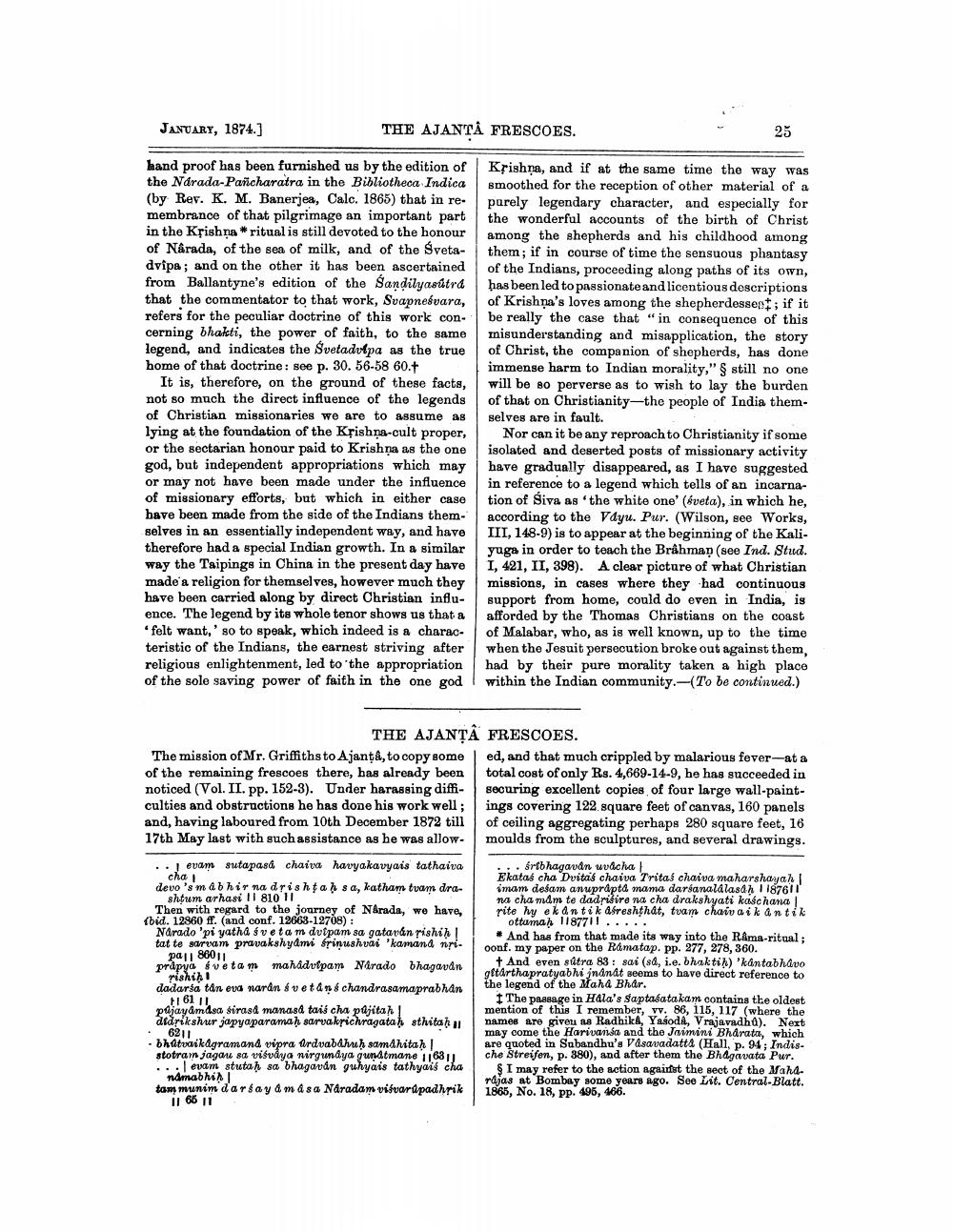________________
THE AJANTA FRESCOES.
JANUARY, 1874.]
hand proof has been furnished us by the edition of the Nárada-Pancharatra in the Bibliotheca Indica (by Rev. K. M. Banerjea, Calc. 1865) that in remembrance of that pilgrimage an important part in the Krishna ritual is still devoted to the honour of Nârada, of the sea of milk, and of the Svetadvipa; and on the other it has been ascertained from Ballantyne's edition of the Sandilyasútrá that the commentator to that work, Svapneśvara, refers for the peculiar doctrine of this work concerning bhakti, the power of faith, to the same legend, and indicates the Svetadvipa as the true home of that doctrine: see p. 30. 56-58 60.+
It is, therefore, on the ground of these facts, not so much the direct influence of the legends of Christian missionaries we are to assume as lying at the foundation of the Krishna-cult proper, or the sectarian honour paid to Krishna as the one god, but independent appropriations which may or may not have been made under the influence of missionary efforts, but which in either case have been made from the side of the Indians them selves in an essentially independent way, and have therefore had a special Indian growth. In a similar way the Taipings in China in the present day have made a religion for themselves, however much they have been carried along by direct Christian influence. The legend by its whole tenor shows us that a 'felt want,' so to speak, which indeed is a characteristic of the Indians, the earnest striving after religious enlightenment, led to the appropriation of the sole saving power of faith in the one god
THE AJANTA
The mission of Mr. Griffiths to Ajanțâ, to copy some of the remaining frescoes there, has already been noticed (Vol. II. pp. 152-3). Under harassing difficulties and obstructions he has done his work well; and, having laboured from 10th December 1872 till 17th May last with such assistance as he was allow
evam sutapas& chaiva havyakavyais tathaiva cha 1 devo's mabhir na drishtaḥ sa, katham tvam drashtum arhasi 11 810 11
Then with regard to the journey of Narada, we have, (bid. 12860 ff. (and conf. 12663-12708) :
Narado 'pi yatha svetam dvipam sa gataván rishiḥ tat te sarvam pravakshyami srinushvai 'kamana nripall 86011
prapya ve tam mahâdvipam Narado bhagavan rishiḥ
dadarsa tân eva narån svetâns chandrasamaprabhân 1 61 11
pajayamasa siraså manaså tais cha pajitah didrikshur japyaparamaḥ sarvakrichragataḥ sthitah 6211
bhatvaik@gramana vipra ardvabahuḥ samahitaḥ | stotram jagau sa visvaya nirgundya gunatmane 116311 ...evam stutaḥ sa bhagavan guhyais tathyais cha namabhiḥ tam munim darsay âm â sa Nâradam viśvarúpadhrik 11 65 11
25
Krishna, and if at the same time the way was smoothed for the reception of other material of a purely legendary character, and especially for the wonderful accounts of the birth of Christ among the shepherds and his childhood among them; if in course of time the sensuous phantasy of the Indians, proceeding along paths of its own, has been led to passionate and licentious descriptions of Krishna's loves among the shepherdessent; if it be really the case that "in consequence of this misunderstanding and misapplication, the story of Christ, the companion of shepherds, has done immense harm to Indian morality," § still no one will be so perverse as to wish to lay the burden. of that on Christianity-the people of India themselves are in fault.
Nor can it be any reproach to Christianity if some isolated and deserted posts of missionary activity have gradually disappeared, as I have suggested in reference to a legend which tells of an incarnation of Siva as 'the white one' (éveta), in which he, according to the Vayu. Pur. (Wilson, see Works, III, 148-9) is to appear at the beginning of the Kaliyuga in order to teach the Brahman (see Ind. Stud. I, 421, II, 398). A clear picture of what Christian missions, in cases where they had continuous support from home, could do even in India, is afforded by the Thomas Christians on the coast of Malabar, who, as is well known, up to the time when the Jesuit persecution broke out against them, had by their pure morality taken a high place within the Indian community.-(To be continued.)
FRESCOES.
ed, and that much crippled by malarious fever-at a total cost of only Rs. 4,669-14-9, he has succeeded in securing excellent copies of four large wall-paintings covering 122 square feet of canvas, 160 panels of ceiling aggregating perhaps 280 square feet, 16 moulds from the sculptures, and several drawings.
értbhagavan uvacha |
Ekatas cha Dvitas chaiva Tritas chaiva maharshayaḥ imam desam anuprapta mama darsanalalasah 1187611 na cha mam te dadrisire na cha drakshyati kaschana! rite hy ekantik aéreshthát, tvam chaivaik antik ottamaḥ 1187711..
And has from that made its way into the Rama-ritual; oonf. my paper on the Rámatap. pp. 277, 278, 360.
And even sûtra 83: sai (sa, i.e. bhaktiḥ) 'kantabhavo gitarthapratyabhi jnânât seems to have direct reference to the legend of the Maha Bhar.
The passage in Hala's Saptasatakam contains the oldest mention of this I remember, vv. 86, 115, 117 (where the names are given as Radhika, Yasoda, Vrajavadhú). Next may come the Harivansa and the Jaimini Bharata, which are quoted in Subandhu's Vasavadatta (Hall, p. 94; Indische Streifen, p. 380), and after them the Bhagavata Pur.
SI may refer to the action against the sect of the Mahdrajas at Bombay some years ago. See Lit. Central-Blatt. 1865, No. 18, pp. 495, 466.




